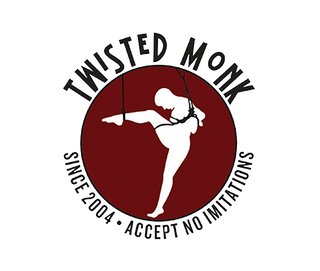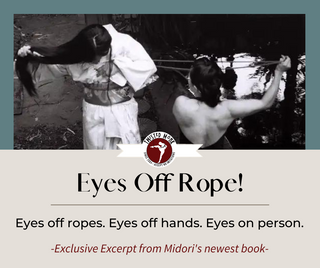Eyes Off Ropes A reminder
Eyes Off Hands A practice
Eyes On Person A discipline
The joy of shibari is being with – being with oneself, being with the other -- in the shadows of our psyche. To see a glow in the dim grayness of the Now. This place is not a place to avoid. Instead, it's a space you intentionally create, without the bright flashing distractions and razzle-dazzle pulling apart our attention in a thousand of thousand directions.
To play with rope is to be willing to create an encounter where our senses are sharpened and the noise of the inconsequential is quieted.
A path -- just one of many paths -- to get there is:
Eyes off ropes,
Eyes off hands,
Eyes on person.
With shibari, it's common to focus our gaze on the knots, the ties, and our hands tying them. This impulse to watch our hands or knots is especially true, common, and understandable when the skill or the activity is new to us.
But tracking the knots and production of our hands can become noise itself, demanding our attention and pulling us away from anything else. For many, this provokes accompanying concerns or persistent thoughts of worry, inadequacy, competitiveness, and of not being good enough. Why invite this emotional bully into your play?
There are many things we do with our hands, complicated and nimble tasks, where we don't look at our hands or the details of the job itself.
Keyboarding. Bringing a mug of steaming hot coffee to your mouth. Operating a game console. Zipping your pants. Buttoning your shirt. Buckling and unbuckling a belt. Driving a car. Riding a bike…. just to name a few.
We are built to know our body position and movements and to perceive our actions and immediate surroundings with senses beyond sight. Some of us have a keener sense of these than others. It's so much part of our functioning that we're unaware that we're constantly sensing ourselves, relative to the world, without looking.
Proprioception: the awareness of posture, movement, and changes in equilibrium
“Proprioception (or kinesthesia) is the sense through which we perceive the position and movement of our body, including our sense of equilibrium and balance, senses that depend on the notion of force (Jones, 2000).”
From: Psychology of Learning and Motivation, 2013
“Kinesthesia is defined as the ability to sense the extent, direction, or weight of body movement.”
From: Physical Therapy of the Shoulder (Fourth Edition), 2004
These evolutionary "automation" features free a considerable part of our brains, allowing us to pay attention to pleasure, play, and our partner. It enables you to perceive the signals transmitted through the ropes and all your senses with finer acuity.
~ Eyes on Person ~
"Eyes on person" can be about looking directly at a person with your eyes, but really, it's metaphorical. It's not about eye contact or deep eye gazing. Of course, you can also enjoy deep eye-gazing if it pleases both of you.
Here, "eyes on person" is about attention – seeing with your inner sight. To see both your partner and you. To have your internal gaze on both of you can feel weird and require a lot of practice, and likely won't come easily at first. If anticipating or planning takes up a lot of your brain during a scene, you'll need to give up some of that – or all of it -- if you dare.
Question:
When should you start taking your
eyes off rope?
When should you start taking your
eyes off hands?
When should you start taking your
eyes on person?
Answer:
Immediately.
To make this a good habit, a streamlined unconscious behavior, begin as soon as you start playing with rope and at the beginning of each scene. Your ties will likely look messy at first. Let them be messy and imperfect. You will improve. This habit centers you on the human experience of the scene and its flow. I strongly encourage you to start with very few basic ties. Don't try to 'master' dozens of shapes at once. That's like attempting to learn multiple ballroom dance steps at once when you're new and still trying to watch your feet and move with a partner. Be kind to yourself. Do a few things really well, not many things poorly.
Here is one practice process idea to help you master this and good tying skills.
- Find a super basic two-column tie. There are many variations of two-column ties. Pick one that you like or looks easy. Here's one from the Twisted Monk video archive i.
- Try it once or twice while looking at the video (or other source of your choosing). You can look at the rope and your hands for this round. Tie this onto another person's wrists, your own legs, or two broom handles – really, anything.
- If you're learning from a video or book, move that educational source away from your hands and the two columns you are tying. Keep your eyes on the video or text and tie the two columns.
- When done, take a look. It's totally fine if it's messy or it didn't hold.
- Take your eyes off the two columns. Undo without looking.
- Repeat.
- At some point, remove the video or book. Find a spot about eye level to look at. Keep your eyes on that, and repeat.
- If you are tying onto another person, look at their face and have a conversation while repeating the tie.
- Bonus Advanced Practice! Are you intimate with them? Without looking at your hands, tie two columns while making out or engaging in sexy talk while tying. Perhaps try to practice the tie while getting your sexy groove on.
- When you feel confident with steps 1 to 9, move on to a new tie. Perhaps a single-column tie, or a basic chest tie.
The above process is a solid and fun way to learn the new ties – trying, tying, and learning with eyes off ropes, eyes off hands, and eyes on the person.
Tip: "Chin Up!"
When casting, do you find it challenging to keep your "eyes off hands"? Remind yourself to lift your head – or "chin up!" It really does help.
"Chin up!" has the additional benefit of shifting you into a better posture. Good posture projects confidence to your partner, helps you feel grounded and confident, and reduces back aches and discomfort. "Chin up!" sets you up for healthier ergonomics.
"Eyes on person" and "chin up" may also allow you to notice early signs that the scene is going in an unexpected and possibly undesirable direction. Equally, it may allow you to more clearly perceive your partner's joy, delight, pleasure, and happiness.
----
Midori's Bio
Trailblazing educator, sexologist, artist, and irritant to banality, Midori founded Rope Dojo and ForteFemme: Women's Dominance Intensive. She penned the first English instruction book on shibari titled "Seductive Art of Japanese Bondage" in 2001, paving the way for the popularity of rope. Dan Savage calls her the "Super Nova of Kink," while others affectionately call her Auntie Midori for her cool, tell-it-like-it-is, funny, reality-based teaching. She is also the author of "Wild Side Sex," "Master Han's Daughter," and "Silk Threads."
During this pandemic, learn, laugh and enjoy her special online classes, events and art at www.patreon.com/PlanetMidori
Instagram: https://www.instagram.com/planetmidori/
Facebook: https://www.facebook.com/MidoriReallyMidori
Creative Living Coaching and Private Sexological Consultations: ask@planetmidori.com

